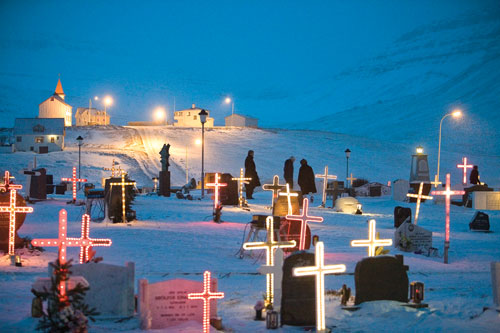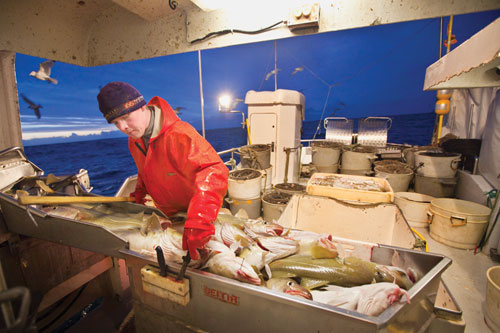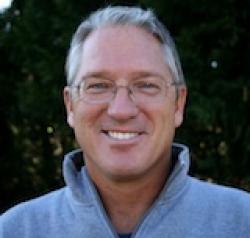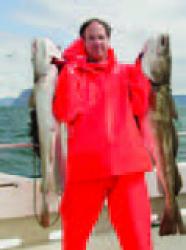-

- Gu∂ni Thorberg Theodórsson in the process of retrieving a 35-mile-long continuous fishing line aboard the vessel Einar Hálfdáns.
-
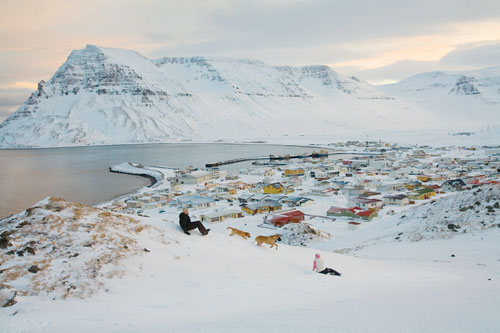
- Ágúst Svavar Hrólfsson and Birna Hjaltalín Pálmadóttir walk their dogs in the midafternoon sunset. Nestled in its tight valley, Bolungarvík sees no sunshine in December and January, so locals climb the ridge tops for solar visits. Working on a thirty-day trawler out of Reykjavík, Ágúst was enjoying time at home before heading back to sea. Two weeks later, he was thrown across the open deck of his ship and broke his back.
Time is like water, and the water is cold and deep …
—Steinn Steiner, Icelandic poet (1908-1958)
“Did you see the northern lights last night?” Captain Geiry asks. He smiles and tosses up his right hand, which is gloved by red insulated rubber, then shakes his head. “They were … amazing.”
It’s 8:30 in the morning, and the sky is still a midnight-black. Just another Wednesday in February. We’re in the village of Bolungarvik, Iceland, almost precisely where that nation’s vertical, rocky, treeless, northwest Fjords intersect with the Arctic Circle and the North Atlantic. Last night, until the blizzard died about 2 a.m., the wind roared constantly at fifty miles an hour, driving white-out snow sideways. This morning-with the snow subsided but the wind still gusting-the whipped-up seas outside the harbor are running twenty to thirty feet. For today’s work, we are boarding Geiry’s thirty-six-foot commercial fishing boat, christened the Sirry, that, at its widest, sits ten-feet at the beam. The waves will be far larger than our boat. The ocean temperature hovers at freezing. This is the kind of challenge, I am coming to learn, that Geiry loves. He is tall and thin, with a crop of graying hair and a handsome, long-nosed, and craggily weathered face. His full name is Sigurgeir Steinar Oransson, but everyone knows him as Geiry. And he can’t stop smiling.
In the morning’s darkness, the wharf is lit in pools by floodlights. Geiry uses a fifteen-foot-tall hydraulic crane to load barrels of baited “long lines” and the last of the “catch boxes” aboard the Sirry. The thirty-six stacked buckets of pre-baited line-all eighteen miles of it, a half-mile in each bucket-have been set gently onto the working deck near the transom. Most of the catch boxes go below-eased into the hold through a wide trap door. All but one is empty now, but each is designed to hold one-quarter of a metric ton of freshly harvested fish (the day’s “catch”). Only the last box is loaded full-packed with another quarter-ton of clean, shiny, chipped ice just delivered by forklift from a fish processing warehouse a few hundred yards away. The ice, even here in the frigid and wind-scoured morning darkness along the Arctic Circle, is critical to successfully bringing in a harvest of fresh Icelandic fish. Working the crane’s levers with delicate efficiency, Geiry nestles the ice box into its reserved hole in the middle of the hold.
-
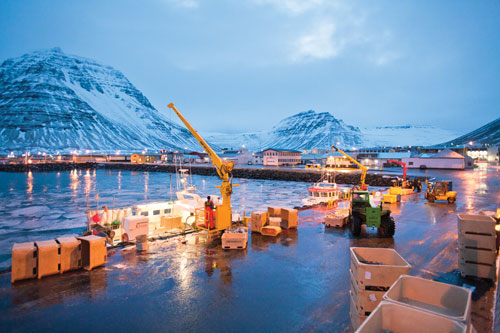
- At the dock in Bolungarvik, cranes offload empty fishing lines then boxes of fish for weighing. Icelandic officials track catch weights against the quota a particular vessel is allowed. If, at the end of the season, a boat has caught more of a particular fish than is allowed, the owner must pay for more quota.
With that, he’s ready to get aboard the Sirry and begin today’s ninety-minute run to his chosen fishing grounds. Geiry grins wider, expectant. He extracts the crane’s cables from the boat, stowing them for the next user. He uncleats the mooring lines, then climbs down a steel ladder bolted to the seawall. The water of the harbor is as black as the sky and undulates sinuously. Once Geiry is on deck, he walks to the glass-and-steel wheelhouse. Just inside the door (which is heavily latched to keep the North Atlantic out should the boat roll completely over in heavy seas), he removes his knee-high rubber boots, sliding his feet and thick gray socks into a pair of blue Crocs. As he fires up the engines, Geiry is all smiles. He can’t wait to get going.
“Today we’re going to a place called Utaf Skelavik,” Geiry says. “It means ‘Out from Skelavik,’ or ‘Out to the Inlet.’ It is north of the island. Because winds have been coming all night from the south, we will use the mountains to block the wind.”
He turns the wheel away from the wharf and ups the throttle. The engine growls.
“Let’s do this,” he says.
In a world where most commercial fisheries are withering, the seas around Iceland continue to thrive.
The reason is simple: back in 1984, after three years of rigorously monitoring their commercial daily catches and corresponding fish populations, the people of Iceland and their national fisheries and resources departments collectively decided that, rather than pillage their oceans as the rest of the world was doing, they would more closely manage the riches taken from their waters. They understood that, with regard to fishing, the universe was both finite and possible to preserve. So using fish population studies and documented harvests as baselines, Iceland established a conservative yet reasonable system of catch quotas.
They had good reason. By the 1970s, commercial fishing had gotten almost too efficient. Huge ships dragged enormous, open-mouthed nets called trawls. These were pulled along the seabed by long cables, the nets following dangling chain “ticklers” that stirred up the seafloor in their advance and helped drive sluggish fish into activity, ensuring a more-certain harvest. The boats then scooped up all fish and much of the collateral sea life, leaving the seabed an underwater desert in the process. Icelanders decided there had to be a better way. They began to regulate huge trawlers, setting strict limits on their catches. The practice of small-boat long-line fishing (which is less efficient but also does far less damage to the seabed) was encouraged through economic incentives.
The restrictions have yielded the most successful and sustainable commercial fishery in the world-but they haven’t always been easy to enforce. Throughout the 1970s, the British, Danish, German, and Norwegian fleets had harvested huge catches of cod, haddock, and pollock everywhere in Iceland’s vicinity. To restrict catches off their shores, Iceland expanded their national ocean-boundary limits to keep non-Icelanders out. At first they declared the boundaries to extend six miles offshore, doubling the traditional three-mile limit. A few years later, they extended the boundary to twelve miles. Ultimately, in the late 1970s, Iceland stretched the boundary to a whopping two hundred miles offshore.
The United Kingdom refused to recognize these new regulations. And when British trawlers arrived in Iceland’s protected waters to fish in violation of the new boundaries, Icelandic fishermen and their Coast Guard fought back, setting into motion what have come to be known as “the cod wars.” The wars-which corresponded to the three extensions of Iceland’s fishing boundaries-were short and sometimes violent. All told, upward of fifty trawler dragnets were severed by Icelandic Coast Guard ships, which would swing close astern of the fishing boats while trailing mine-sweeping cable-slash tools. Shots were fired. British fishing boats were rammed at sea. The Icelanders weren’t screwing around. The British fishing fleet-a proud legacy from one of the world’s great naval cultures-fought back, battling to protect their access to fish and chips. Yet the Icelanders proved adept seafarers with a home-field advantage. In the end, a recognized two hundred miles it would be.
Other nations began to claim their own two-hundred-mile fishing zones, but few had Iceland’s manageable population and ample seafaring resources. Most famously, the Canadians, with their rich Grand Banks fishery in the North Atlantic, also claimed a two-hundred-mile limit, but the laws were less stringently enforced, even as commercial fishing technology continued to improve. By 1992, Canada was required to place a moratorium on all North Atlantic cod fishing inside its boundaries, leaving thirty thousand Canadian Maritime fishermen and many more associated businessmen out of work.
-

- A fisherman walks to work through 55 MPH wind gusts. On this day, the seas were too rough at the protected entrance of the harbor for the Thorlakur to safely exit.
But it wasn’t just the Canadians who’d fished themselves into trouble. According to the United Nations Food and Agriculture Organization, today a full 60 percent of all fish worldwide qualify as fully exploited, over-exploited, or depleted. And as most oceans find increasingly more people searching for fewer and fewer fish, Iceland stands alone as the place where aquatic riches are both healthy and rigorously protected. Despite a widely reported national financial meltdown in Iceland over the past few years-due to unwise investments-the European Union continues to woo Iceland to join its regional syndicate. This, not coincidentally, would also give EU countries access to Iceland’s fishery. Over and over, the Icelanders have responded with a simple, “No.”
These people recognize what they have, and they will not be threatened or bamboozled out of it.
“Don’t get me wrong, the quota system is not perfect,” says a recently retired fish processing executive named Gudmundur Oskar Reynisson, who now works in engineering in Reykjavik. “The quotas have not always been easy for the fishermen. Revisions to Iceland’s quota system have been tried. But there seems no better way to protect the fishery than to control our catch with quotas. Fishing is part of Iceland’s soul. It is our blood. We need it.”
The Sirry has been running for ninety minutes now in darkness-and through some damned heavy seas. Waves roll at us from the starboard, washing over the bow. The swells are moving dunes of water: dark and foamy, their iridescent and wind-driven whitecaps visible in the false dawn of 10 a.m. Still, in the wheelhouse, it is warm and dry if a little bouncy. There is fresh coffee. A radio station plays classic rock hits-“Our House” and “Start Me Up” and “Sign Your Name Across My Heart”-as Geiry watches his GPS on a flat-screen near the ship’s wheel. He orients his boat to begin laying out line. He nods to Toti, his mid-twenties son and crewman. Toti suits up in orange waterproof bib overalls, an orange waterproof slicker with toti magic-markered large onto its back, insulated orange boots, and orange insulated rubber gloves. He then opens the door and steps outside the wheelhouse, walking back across the deck to the Sirry’s stern.
Like Geiry working the crane this morning, Toti’s movements are casual yet efficient. He lifts a thirty-pound lead weight attached to about two hundred feet of cord, and lays it on the transom as the boat continues to roll with the seas. He slides into place the first bucket of pre-baited hooks on a long-line-maneuvering it to the foot of what resembles a small, stainless steel children’s slide going up over the boat’s stern. Using a carabiner at one end of the pre-baited line, he clips the hooks to the weight. Then he grabs a buoy-already clipped to the weighted line and with a floating ball and a tall flag above it-and carries it over near the weight and the first pre-baited barrel. Toti stands ready, watching Geiry through the rear picture windows of the wheelhouse.
Geiry steers the boat and watches a map of well-used GPS waypoints now overlaid upon an underwater map. These coordinates are important, as they not only to mark the day’s route for future reference, in case our work brings big catches or especially poor ones, but also because as we motor back to where we started laying the line, the float might otherwise be hard to locate amid today’s enormous swells. As the Sirry joins a blue GPS line on the map, Geiry turns, looks back to his son, and nods.
The weight goes over the side. The baited line, with its hooks carrying diced bits of white squid hooked on small offshoot strings every yard or so, begins to stream up the stainless steel slide and over the stern, too: the squid chunks like paratroopers departing an airplane. As the weight descends into 180 feet of cold, roiling ocean, the baited hooks just keep going. Each pre-baited barrel has two carabiners attached to it-one on each end of the line, with the clips left hanging outside the barrel’s edge. One is attached to the leading edge of the line, the other to its far end. As the weight cord finishes descending to the bottom without snarling, Toti tosses the flagged float over the side. And then, for the next eighteen miles at sea, Toti continues to exchange one pre-baited barrel for the next-clipping carabiners together to connect them-until all thirty-six barrels of pre-baited line are empty. Then, at the far end of the long line, he attaches a second two-hundred-foot length of cord and lead weight, hooked to an orange float-ball buoy.
And with that, the first half of today’s fishing is done. By about 11:30 a.m., it’s time for lunch: sandwiches and Cokes and a bag of chips. As we motor back toward where we started, Huey Lewis and the News pumps through the speakers on the wheelhouse radio. It’s “The Power of Love.”
Depending on whom you ask, Iceland was settled either by Irish monks in the seventh century or by a Norwegian navigator (and alleged fugitive) named Ingolfur Arnarson in 874. In the latter and more verifiable history, Arnarson arrived with his family and servants by private ship at a place he christened Smoky Bay, due to the volcanic vents that created and define the island. As word got out about the bay, a wonderful natural harbor, others arrived. With a rich fishery and small, birch-like trees to help build shelters, the settlers created their own form of rustic prosperity. Eventually Smoky Bay would become the capitol of Reykjavik, where today more than half of the country’s 313,000 residents live. In fact, things grew so good that, by 1232, there came a period of wars in the form of intra-island clan disputes, not to mention assaults from outside nations desiring the island’s riches. In 1262, Icelanders finally ceded themselves to Norway, only to be taken under Danish control in 1367. Yet through it all, with regular calamities from volcanoes and the whims of world economics, the island’s human inhabitants have beaten long odds, demanding weather, and enforced solitude-largely by fishing for cod.
Cod are the cattle of the ocean. They are neither wily nor intelligent. They are slow-moving, almost torpid throughout their days, and swim much of the time with their mouths open, using vacuum pressure provided by their gills to suck up anything on the sea floor that touches their lips. It is said that British fishermen find Styrofoam cups in the guts of cod they are cleaning. While they possess enormous appetites, once hooked they put up almost no fight and can be dragged to the surface without great effort. They also prefer water that is not too deep, often living in seas shallower than two hundred feet. When the navigator John Cabot returned to England from his voyage to the New World in 1497, it was storied that to feed themselves his ship’s men often simply dropped ropes with weighted baskets overboard and hauled up more codfish than they could stomach.
Cod are the cattle of the ocean. They are neither wily nor intelligent. They are slow-moving, almost torpid throughout their days, and swim much of the time with their mouths open, using vacuum pressure provided by their gills to suck up anything on the sea floor that touches their lips.
The cod’s flesh is also extraordinarily well-suited for human consumption. It is almost fat-free (0.3 percent), but is also heavy with protein. For centuries, the oil of its liver has been said to improve human health and promote longer life. Because it feeds lower on the food chain than other big, predator fish like tuna, swordfish, or sharks, it is relatively free of the mercury contamination that makes those fish dangerous to eat. The flesh of a cod can be eaten fresh or salt-cured. It can be smoked or preserved in water or olive oil. And dried salt cod, like beef jerky, can be reconstituted by soaking it for a period in water, returning it to cook-able softness. In short, it is the ideal food source for an isolated island with no native large mammals to hunt and a vertical, volcanic landscape resistant to farming.
And that spartan isolation has often served Iceland’s interests; their longtime national protectorate of Denmark, after all, sat hundreds of miles to the east across tumultuous seas-and thus had no easy way nor strong incentive to get involved in Iceland’s day-to-day life. In 1944, with the rest of the Atlantic world engulfed by war, the Danes and their German Wehrmacht occupiers allowed Iceland its independence. With the stroke of a pen, Iceland became an island nation untouched by World War II’s global calamity-and it quickly exploited its location and natural gifts. It hosted the British and American naval and air forces at a place called Keflavik, a few dozen miles south of Reyjavik’s Smoky Bay.
Suddenly, with freedom overlying a long-hewn natural parsimoniousness, Iceland had arrived as its own happy and well-funded place. And yet, as it had from the beginning, much of the success of Iceland’s people remained built on a foundation of regular and predictable harvests of cod.
With lunch finished aboard the Sirry, it’s time to get back to work. Having the flagged “start buoy” in sight, Geiry and Toti put the lunch dishes away (the Sirry has a galley and six sleeping berths beneath its foredeck), and begin to put on their waterproof outerwear, boots, and gloves. Just before he pulls on his gear, Geiry flips a switch on the wheelhouse console, moving control of the boat to a steering wheel and throttle on the outdoor working deck of the Sirry.
Despite the weak, filtered February sun low on the horizon, working outdoors at sea this time of year is cold. And windy. And loud. As he steers the Sirry for the start buoy using the outside wheel, Geiry grows serious. Knowing the next several hours will be nothing but work, Toti smokes a quick cigarette, then lifts several stainless steel chutes from where they have been stowed on the deck. Each has a pair of u-shaped hooks on their top, and Toti fastens these to the sides of the open hatch, each chute’s far end connected to one of the different catch boxes located in the Sirry’s hold. This is their sorting system. Large cod will go in one box; smaller cod in another. Pollock will go in another. And the ferocious, toothy, malevolently slow-to-die fish called wolf fish-or ocean catfish or steinbitter “stone-biter”-will go in another. When each bin begins to fill in thirds, Toti will climb into the hold, standing on the edges of the ice box in its center and use a snow shovel to cover each new layer of catch with chipped ice.
-

- In the failing light of early afternoon, the two-man long-line boat Einar Hálfdáns motors back up Isafjord to its home port of Bolungarvik. The sheer cliffs of the unpopulated Hornstrandir peninsula rise in the background.
-

- Watching the crane chains, Gudbrandur Jonsson is part of the team that will offload the hold of the Thorlakur. Sorted by species and size in the ship’s hold as they are caught, the vessel’s fifty tonnes of fish will go to the Jakob Valgeir processing plant.
-
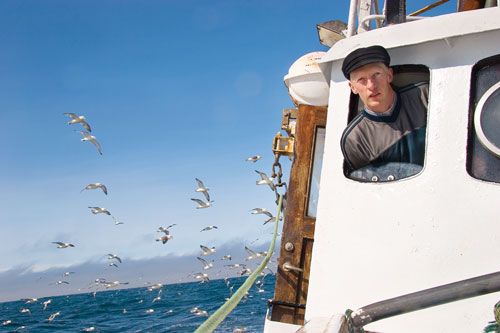
- Sigurgeir “Geiry” Steinar Thórarinsson pilots the Jörun, his deep-sea net boat, back to Bolungarvík after a bad day. He badly damaged both of his dragnets and caught only a half-tonne of fish. In 2009, he sold this boat and transferred his catch quota to the two-man, long-line vessel Sirry-greatly improving his yields.
-

- Ingibjörg S. Gumundsdóttir watches her twin daughters at the annual New Year’s bonfire. The fire department throws kerosene on the mountain of wooden pallets to keep it burning in subzero temperatures.
Motoring up to the flag, Geiry and Toti snatch the start buoy from the water, and then thread its line through the winch: a series of grooved aluminum discs powered by the Sirry’s idling engine. It will draw the line up from the bottom of the sea. As the discs spin, the line is pulled to the surface as if by a motorized block and tackle. It’s a remarkably simple, elegantly engineered system. Just before the line hits the discs, the fish are pulled across a flat steel table and through a close-set pair of vertical metal rollers. The table holds each hooked fish as it’s hauled aboard. As the fish’s mouth arrives at the rollers, the rollers disengage the hook. The line then continues to be drawn over the discs down under the table into a waiting-and empty-bucket that formerly held pre-baited line. (At the end of the day, the buckets will be returned to baiting shops that will prepare them for another trip out.) When one bucket fills, it is unclipped and replaced with a new empty bucket.
Once the line is stowed, each hooked fish is pushed along a second steel slide. This slide ends just above a large box with a floor that can be raised and lowered hydraulically by a pedal. When the box gets filled, Geiry or Toti will begin bleeding the fish, using very sharp fillet knives to cut their throats just behind the lower gill slits. Then the fish are sorted by species and size and sent down the stainless steel chutes into their appropriate catch box in the hold. For the next several hours, steering the Sirry and looking through the wheelhouse’s window to follow the GPS track on the computer screen near his captain’s chair, Geiry pilots the boat and gathers the fish. To pull the large fish aboard, he uses a koli, which is a long pole spiked with a gaff. The cod are enormous-perhaps eighty or a hundred pounds-and have mottled brown skins and gaping maws and dull black eyes. Most of the fish are smaller, between five and twenty pounds. The pollock and haddock, which run about ten pounds each, are bright silver and have shinier black eyes. As more line comes in and stacks up, the barrels continue to be swapped out. When the hydraulic-floored deck box fills, Toti steps over, cutting, bleeding, and sorting the fish with amazing speed, sending them down the stainless steel chutes into the catch boxes below.
-

- The Grill is the one business in sleepy Bolungarvík that stays open past 8 p.m. The Grill is also the only place to rent DVDs or get junk food-like ice cream, hot dogs, and pizza.
By mid-afternoon-with the Arctic sun now tilting toward sunset-Geiry and the Sirry keep pulling hooked fish aboard: one with almost every yard of retrieved line. Few hooks come up without a fish. As Geiry keeps sliding fish toward the deck box for bleeding and sorting, he looks over and smiles. “I’d say, so far, we’ve got 2,870 kilos,” he says. Most days, he adds, the final catch will run somewhere between four and seven tonnes.
If there is a prototypic Icelandic fishing village, Bolungarvik is it.
Set around a protected harbor, with mountains sheltering it from the harshest North Atlantic weather, the town is home to just 930 souls. The streets are arranged on grids, with neat houses along them. There are no hotels and only one restaurant-bar (only open on special occasions), one post office, two gas stations, and one grocery. There is a large sporting complex-open twenty-four hours a day with a gym, an indoor soccer field, a full-sized pool, and geothermic hot tubs-but the rest of the town is either about work or sleeping. All more-complicated human needs must be met by a half-hour drive to the larger town of Isafjordur.
-
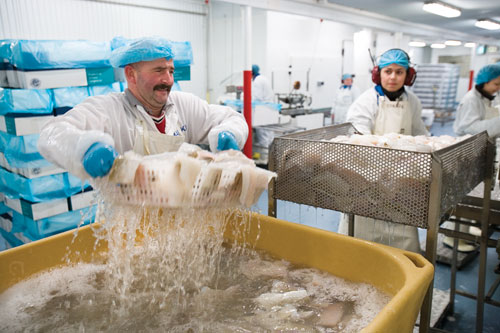
- Dariusz “The Soldier” Putkowski, one of Bolungarvík’s many Polish guest workers, lifts brined cod out of a holding box. Karitas Ingimarsdóttir will weigh the fish for boxing and shipment. Women do all the cleaning and trimming, while men do the lifting and hauling.
The harbor is lined by warehouses. Some of these low buildings are for re-baiting barrels of long-line hooks; they are fronted by large refrigerated containers the size of semi-truck trailers, so the newly prepared barrels, once re-loaded, can be preserved without the bait spoiling. Other buildings, known as fresh-market processors, take part of each catch from the harbor’s fifty-two commercial fishing boats, fillet them mechanically, process their livers for oil, and then ship the fillets across the planet as Fresh Icelandic Cod. The largest warehouses along the wharf, however, are industrial fish processing plants. These either salt and dry the fish, prepare and box fresh salted bacalao for shipment to Spain and Mediterranean Europe, or deep-freeze whole cleaned sides of cod at -35 degrees Celsius for shipment to Great Britain for fish and chips (though some is shipped farther afield by air freight). While there were historically several such buildings working along the harbor, today there is only one still-functioning large processor. This is one negative repercussion of the quota system: with fewer fish being harvested, it was survival of the fittest along Bolungarvik’s waterfront.
At this last industrial fish processor, called Jakob Valgeir, what goes on inside the warehouse is nothing short of a business-school study in industrial cleanliness and automated precision. Most of its flat surfaces are sheathed in Corian, so they can be easily washed and cleaned several times daily. Everything is mechanized and computer-controlled. To take a tour, you must remove your shoes and pull on sanitary boots at the door of the clean area, then you put on a white gown and a head-covering hair net. The light inside the plant is bright and pervasive; it also seems to deliver no shadow. And everywhere inside, conveyor belts are moving fish.
We begin at the warehouse’s far side in a spotless refrigerated zone where a guy seems to be constantly hosing down the walls and floor. “The boats come in and the fish come here by forklift after being loaded off the boats,” says Gudbjatur Flosason, one of Jakob Valgeir’s production managers. A tall dark-haired guy in his thirties, he’s friendly and obviously proud of the factory. “The fish are brought into this refrigerated area through the back doors, already in their catch boxes,” he says, moving fast across the wet concrete of the facility’s production floor. From here, the boxes are dumped by a special forklift into a stainless steel processing bin at a door between the plant and the refrigerated warehouse. As a conveyor belt begins moving the fish, computers beneath the belt weigh each individual fish, then sort it by a second conveyor belt inside the clean area. There, the fish are more precisely weighed and sorted again by devices that look like stainless steel pinball flippers, directing fish of different sizes onto different conveyor belts. Each fish is then mechanically oriented to move down the belt belly-down and head-first, drawn toward sets of spinning knives, where the fish is gutted, mechanically filleted, and de-headed using laser and electric-eye computer assessment. No human hands ever touch a fish.
And virtually nothing is wasted. Each fish’s severed head drops onto a lower conveyor belt, which shunts it to another facility where it will be dried and shipped to West Africa for flavoring soup. The livers are separated out by gloved hands and dropped onto a different belt for processing into cod liver oil. About half of the fillets are salted and conveyed down the center of a long, Corian-covered worktable, where a score of women cut them into whole, perfectly rectangular, ten-ounce portions. These are individually wrapped in plastic and packed by the half-dozen into blue boxes labeled in Spanish. Larger fillets are sent to another conveyor belt that runs through a huge industrial freezer, after which they are boxed for shipment to Britain and beyond. The scraps of cod, pollock, and haddock left over from all this precise sorting and carving, Gudbjatur says, will be fashioned into fish sticks or “fish hamburgers.”
“From the time a fish is loaded into the system until the time it is cleaned, prepared, and boxed for shipment is never more than five minutes,” says Gudbjatur. He smiles and turns in a circle to take in the huge, glaringly bright room with its shining steel machines and smooth white Corian surfaces in stark contrast to the February morning darkness outside. Amid the mechanized clatter, the people work quietly and purposefully in white coats and sanitized boots, hair nets and sterile gloves.
“Yah,” Gudbjatur adds, still smiling as he takes it all in. “Five minutes from a whole fish to fillets inside a sealed box.”
Not a half-mile inland from the JakobValgeirplant along the waterfront, Soffía “Sossa” Vagnsdóttir sits in her living room, drinking tea. “The quotas have been hard on the town,” she says. “Fifteen years ago, there were fifteen hundred people in Bolungarvik, and you could spend the whole day out shopping. Now the shops are mostly gone. There aren’t enough people anymore. When my father was a fisherman here, he needed someone who could fix his boat. Fishing made jobs. But now, people are just hanging on to what jobs remain. The quota system has been good for the protection of nature. But is has not been good for the people. Maybe I just have to face it: I am dying along with my town.”
Sossa, dark-haired and intense yet friendly, is a music teacher. She is also a town council member and a highest order Bolungarvik autonomist. She grew up here in a large fishing family. In fact, she seems related to everyone in Bolungarvik. For a time, she left town and moved to mainland Europe, falling in love and marrying a man named Roland Smelt, a Dutchman who works in the IT industry. They had several children and moved back to Bolungarvik, with Roland finding tech work in Isafjordur. They seem happy and their children are bright and interested in the larger world. Their house is crowded and busy and wonderfully raucous at dinnertime. Well outside the usually trim Icelandic mode of life, Roland keeps a coop of chickens in their backyard.
Coming back to Bolungarvik was always part of the plan. “This place is part of my soul,” Sossa says. But coming home to confront the quota system was also a shock. “If you don’t have a quota already attached to you or your boat,” she says, “then you have to ‘rent’ quota from someone else.” Currently, buying enough quota capacity to pay for your life and boat costs about 3,250,000 Icelandic Krona (or almost $30,000)-and it’s an open-ended arrangement that extends perpetually into the future, with new payments year after year. “And most of the money made from your fishing goes to the owner of the quota, not to you, the fisherman,” Sossa adds. “When you add in the cost of gas, and the upkeep on your boat, and your time spent to catch the fish, you end up making almost nothing for every kilo of fish you catch. Why would any young person think of going into it? The idea of a life spent fishing? It’s dying.”
Fishing and dying have long been twinned in Sossa’s mind. On December 18, 1990, her father and brother-in-law went out for another day of fishing. Later, her father’s boat was found several miles north of Bolungarvik’s harbor, motoring in circles. “The boat was empty,” she says. “The engine was still running. It was storming, but not storming so badly. Some think they were working and a rogue wave came and knocked them overboard. Some say they got caught in the gear and were dragged overboard. Maybe my brother-in-law, who would have been on deck, went over, and then my father tried to help him and went over, too …” She pauses and thinks. Then tosses up a hand. “We don’t know,” she says.
-

- Soffía Vagnsdóttir, a matriarch in the Bolungarvík community, serves her mother Birna’s famous Kjötsúp, a traditional and fortifying lamb and vegetable soup, in the dining area of her kitchen at Hesteryi.
Almost everyone in Bolungarvik, in fact, has lost family members to commercial fishing. Which is why, despite a love for the town and a deep desire to see it prosper, there also remains resentment for the quota system among the locals. “I mean,” Sossa says, “the restrictions on fishing, we respect them. But they are hurting the future. A young person these days who wants to fish, he cannot buy his way into the quota system. It’s too expensive. The boat is too expensive. We are slowly dying here. The people who own the quota, they grow richer while those who cannot have access must do something else. The economics of fishing has gotten to a place where it affects lives in the future.”
To combat this slow collapse, Sossa has for several years now used her local authority and political position to promote Bolungarvik as a tourist destination. With its picturesque harbor and friendly people, not to mention its nearby access through Isafjordur’s national airport and encircling mountains covered with grass and snow-plus hunting and sport fishing in its creeks and inlets-she and others have begun to imagine a new Bolungarvik. In this vision of the future, managed fishing remains a part of the local economy, but tourism and manufacturing are of much greater significance. Each August, to celebrate the first sunsets of an Icelandic summer, Bolungarvik even hosts a “week of love,” where people are encouraged to take advantage of the night. “Otherwise, I see this town slowly dying,” Sossa says. “In a way, yes, we’re watching the end of the world. But it could also be the beginning of the world.”
A few years ago, at Bolungarvik’s annual Fisherman’s Day, one of the town’s big celebrations in any year, Sossa gave a speech conveying a similar nostalgia for Bolungarvik’s history, with less optimism mixed in. “Bolungarvik is struggling to keep its image as a fisherman’s village,” she told the crowd. “And fishermen are strengthening their position after many difficult years. But the young people are missing. When I was young, the most handsome guys had salt in their hair and the sunset on the ocean in their eyes, with happy faces after the catch of the day … May Iceland’s fishermen be blessed in their work, and those who rest in watery graves be missed and remembered.”
“Tell me this,” Bjarni Hardarson says. “For a young person starting today in commercial fishing, why is it any different than a young person starting out in any other business? Starting is always hard.”
Hardarson, the press officer for Iceland’s Ministry of Fisheries and Agriculture, is sitting in a large, clean office in downtown Reykjavik. Outside the picture windows, the city’s harbor is overlaid by gray mist. There are mugs of hot coffee in everyone’s hand (Iceland runs on coffee), and we are in the office of Johann Gudmundsson, director of Iceland’s Department of Resource Management and Internal Affairs. Gudmundsson sits on the more-serious side of the desk. And the three of us have been talking about history of fishing in Iceland, the quota system, and the future as it relates to both.
“Really, it goes back to the early 1980s,” Gudmundsson says. “When we began watching the catch numbers and the fish populations simultaneously. By late 1983, we recognized we really had a problem with over-fishing. So since then we have become more and more responsible. We also recognize that, while the data came from our marine research authority, as soon as we began to try and legislate the fishery, there would be certain political aspects to anything we did. Economic forces would come into effect. But, long term, we had no choice.”
Iceland is not the United States-where, some days, things have grown so polarized that questions of economic or political legislation always sit one smashed folding chair away from professional wrestling. Conversely, in Iceland, neither Gudmundsson nor Hardarson wants fishing villages to suffer due to the quota system, but they are thinking about the future. “Thanks to the quota system, we have done tremendous good for the [fish] stocks,” Gudmundsson says. He lifts his right hand and wobbles it. “The haddock stock is always fluctuating, but the others are doing very, very well. They’re improving. It’s a long-term plan we have. And we understand the pressures on the fishermen. And they say to us, you should give us more quota, and we have to keep pointing to the marine research and saying: because of these policies things are improving. This is a long-term plan. It will improve life for everyone.”
Rain pelts the broad office windows. Gudmundsson takes a sip of coffee. He is in his late fifties or early sixties, with pale hair and a kind-looking, slightly weathered Nordic face. In the realm of Iceland’s fisheries, he is the adult supervision. It’s Friday afternoon, and this is his last meeting of the day. He picks up a pen and paper and draws a remarkably accurate outline of Iceland’s landmass. Then he begins to draw boxes and taps the pen’s point on the paper in the sea outside the silhouette.
“We monitor closely, all these places,” he says. “We do it the same every year. It’s standardized. With measurement points. There are many points. It’s a national survey. We know what we’re doing. And we also understand, with regard to the fishery and economics, that we’re living in a global environment. We have to sell fish all over the world. We have to be efficient. Our industry has to not only survive but support its people. We also have to balance the future of our fisheries against the equality of economics today.” He pauses and exhales. “It’s a lot to think about.”
What about the young people of Iceland, though? The next generation? What about the notion that all fisheries quota is locked up, and getting access to it is, currently, a financially one-sided situation?
Gudmundsson smiles. “For now, the young people have a problem,” he says. “Yes, yes, I know. But then, people get old, and they need to sell or transfer their operations. The system is not without its problems, but we are trying as best we can.” He pauses, obviously slightly troubled by this reality. Two years ago, Gudmundson finally adds, in an attempt to allow young people some economic incentive to keep fishing on their own, Iceland began to offer four months of free fishing per year. “You have to register, but you can take up to eight hundred tons,” he says. “You have to fish in one of four areas. And you have to report your catch. But it’s possible to make up to 300,000 Krona [about $3,000 per day] if you devote yourself to it. This is one way to help the young people make enough to start in the fishing industry. We’re trying new things all the time, different things. But we also have to protect the resource. That’s the biggest point. Long term, Iceland’s fishing industry needs to be protected so it can survive.”
Back aboard the Sirry and-for reasons no one quite can explain-the fishing has suddenly slowed. Actually, the harvesting of fish has all but stopped. We’ve raised about three-quarters of the eighteen miles of baited line laid down this morning, but now what’s coming back aboard is empty hooks. After a day of rough seas, the waves have calmed into five-foot swells. In dying light at a little after 4 p.m., Geiry stands at the boat’s gunwale, his koli gaff at the ready, but no more fish are arriving. “I think we have something under three tons on board now,” he says. He shrugs. “Not such a good day.” Geiry frowns at the succession of empty hooks come in and shakes his head. “I don’t understand it,” he says. “But, well, at least all the line will be up before too long.”
To pass the time, he lays the shaft of his koli across a wolf fish’s snaggled teeth. The fish, which resembles a twenty-pound black eel, grabs hold. Geiry lifts it from the catch box, leaving it hanging in the air. “These things,” he says. “They are their own kind. Unless you knock this fish off, it will hang here with its teeth locked on until after it dies.” He knocks the fish off, back into the hydraulic fish box on deck.
Then, as we’re still marveling at the wolf fish, something happens. Codfish suddenly begin getting dragged aboard by the winch. And every one of them is huge. One by one, each cod coming aboard is a giant, without question the largest fish of the day: a hundred pounds apiece, some bigger. They come up with almost every hook, every yard of line. Looking over the side of the Sirry, there is a cod traffic jam beneath the boat. The fish pile up in the working deck’s hydraulically-controlled fish box. Toti gets to work, bleeding them at ballistic speed. Still, he can’t keep up.
-

- Pálmi Stefánsson, captain of netboat Pall Á Bakka out of Bolungarvík, prepares to open a net ball of haddock into his boat’s holding bin. To promote sustainable fishing, large-net boats such as this one are restricted to working specific areas.
“Come on, come on,” Geiry says to Toti as the cod overflow. C + C Music Factory’s “Everybody Dance Now” is on the radio. As Geiry and Toti work, they bob to the beat. They are thrilled. The lights of the working deck illuminate everything in a ghostly glow. The cod are going down the chute into catch boxes with industrial regularity. When one box fills, Toti deftly climbs down into the hold and shovels a thick layer of ice over it. Then he re-directs the chute to another, still-empty box. Geiry is smiling. The boxes fill with remarkable speed. Geiry and Toti stay focused on the work. There are cod everywhere. It is Cod World. And the fish just keep coming-hauled up from the floor of Iceland’s sea.
By about 6:30 p.m., the job is finally done. The pre-baited line has all been retrieved. The weights and floats are back aboard. Geiry goes back inside the wheelhouse, removing his gloves, boots, jacket, and waterproof bib overalls and hangs them on hooks just inside the companionway door as he puts his sandals back on. Outside, using a heavy hose, Toti is washing down the working deck as he smokes a cigarette.
Geiry walks to his captain’s chair and flips the switch that returns control of the Sirry from the outdoor deck to the wheelhouse. He bumps up the throttles and turns his boat toward the harbor and home.
Once again, he is smiling. On the radio, it’s INXS and “New Sensation.” Geiry turns up the volume. He looks over and smiles slightly wider. “Four tons today,” he says. They have just hauled up a metric ton of cod in a couple of hours.
Back at the wharf in Bolungarvik, the sky is once again dark. The dark mountains rise up against the sky’s blackness beyond the harbor. Just as it was when we left, floodlights leave pools of illumination on the wharf’s concrete. As we pull in and begin to tie up, what had been a quiet area of town becomes awash with activity. After docking, Geiry climbs back up the wharf’s ladder and off the Sirry. He sets the crane into motion, first pulling off the now-used barrels of pre-baited line and then the now-filled catch boxes, setting them onto the wharf’s concrete. Forklifts from three different companies are waiting: one from the baiting house, one from the fresh market, and one from Jakob Valgeir. In a sort of ballet, the forklifts go to work as well, lifting and moving with choreographed certainty.
-
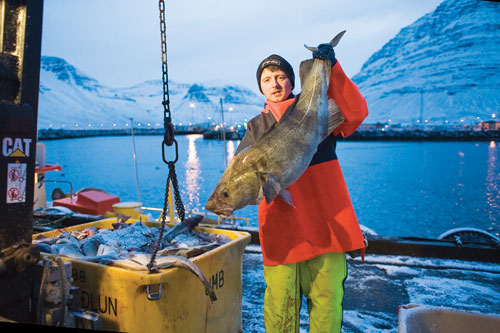
- Pétur Jónsson separates out a large cod from smaller fish. Large fish like this one go to the fresh market, where they command more money, while smaller fish go to the Jakob Valgeir plant.
But before the forklift drivers can take a catch box away, it has to stop at the end of the wharf, where it must be identified by its contents and weighed on an outdoor scale. A forklift sets every catch box onto the scale, removing its tines as a national inspector named “lafur Thor Benediktsson looks on and registers the particulars. Each pound will be logged against Geiry’s and the Sirry’s annual quota. Still, before long, all four tons have been collected, weighed, and taken to the processors, the barrels of pre-baited line dropped in front of the baiting shack. They will be re-fitted in the early morning tomorrow.
As Toti hoses down the Sirry one last time for the day, Geiry is already thinking about tomorrow. He’ll be going out again, he says, in case I’m interested in joining him. But tomorrow’s departure will be earlier, since the weather has improved. He says he’ll likely cast-off around 6 a.m. Then, he adds, before he goes to sleep tonight he’ll probably look out the windows of his house for a while, watching the sky for signs of aurora borealis.
He likes the northern lights.













